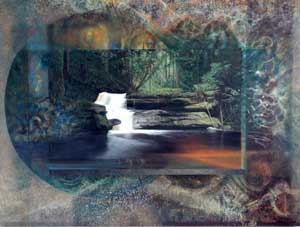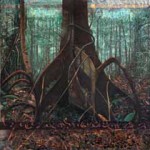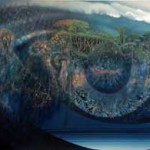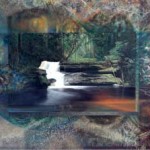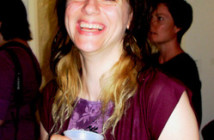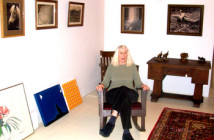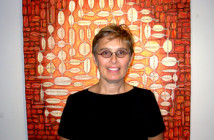Currently Rick Harlow, my next door neighbor in the Eclipse Mill artist/ loft building in North Adams, Massachusetts is spending a month among the indigenous people of Colombia. Recently, he worked for a couple of weeks for a Shaman in Brazil acting as an interpreter and participant in rituals involving the ancient cure and hallucinogen, Ayahuaska. During the winter he spent a month in Colombia. This year he is spending about two and a half months along the Amazon. This is a pattern he has pursued for a number of years with the length of visits to Colombia raging from three to six months and even longer. The results of this immersion in the jungle and participation in visionary rituals are richly evident in the lush, surreal landscapes that he shows at Clark Gallery in Lincoln, Mass.
The day before he departed we met for a beer and burger and a chance to discuss exotic experiences and the decision to settle into the bucolic Berkshires. His primary reason for relocating from Boston to Western Massachusetts was succinct and simple. “I got evicted from my loft which I had for 22 years on Brookline Avenue in Boston right next to Fenway Park (home of the Red Sox) so I had to move,” he explained. “I was looking for large cheap space.” He achieved that as one of the first to buy into the Eclipse Mill taking developer/ artist Eric Rudd’s basic build out for 2,400 square feet for a cost in the mid 90s. He upgraded with sweat equity and about $5,000 in materials. Rick does exquisite finish carpentry and several Mill owners have hired him for projects.
While the Berkshires are hardly as exotic as the jungles of Colombia he has adapted well and is a devoted hiker exploring, photographing and making works of art based on this new environment. I asked why he would leave the Berkshires during the peak summer season? “Actually, having lived here for a couple of years I find that I enjoy all of the seasons equally well,” he said. “Besides, I can live as cheaply in Colombia as I can here.”
Over the years, as a critic, I knew Harlow’s work which was grouped with the artists John McNamara and Roger Kizik under the rubric “Epic Abstraction” which he recalls was coined by former Boston Globe critic, Robert Taylor. He shrugged his shoulders and exclaimed, “Whatever that means.” But it proved to be an effective marketing strategy and in the 1980s the work sold well. There have been steady sales and a firm relationship with Clark Gallery. In the past couple of years, I have enjoyed getting to know him as a strongly committed artist, raconteur, easy going guy with similar tastes in art and music, and a great mate to come to dinner, or down the occasional pint in a local pub. But this time I took notes.
The vital stats are birth 6/14/50 in Winchester a suburb of Boston. From Reading Memorial High he earned a B.F.A from Massachusetts College of Art in 1975 and a M.F.A from the University of Cincinnati in 1979. While he has taught the occasional course he states that “I never wanted to teach.” With a laugh, he states that his last full time job was as a janitor at Mass Art in 1975. Since then he has lived by his wits.
After grad school he traveled to exotic locations starting with Mexico and Central America then on to Indonesia and Borneo. Other than catching connecting flights he didn’t travel in Europe until 1994. He took part in an Orangutan study in Borneo and the Tropical Rain Forrest became the inspiration for large abstract paintings. Other than art, his primary interests were biology, primatology and the natural sciences. “I enjoyed hanging out with large primates,” he said. “That involved spending time in Bali, Java, Borneo and India. On the way home I spent a couple of weeks in Southern England where the cows seemed very fat to me compared to the starving cattle of India. After Borneo I set my mind to living in a Rain Forrest and spent time with the Dyaxtrackers the indigenous people of Borneo. While trekking through the woods it dawned on me that I would be comfortable living with indigenous people.”
When he returned to the States, Rick focused on finding a place to live along the Amazon River and settled on Colombia. It is a relatively short, affordable and convenient flight from Florida. Prior to the first trip he researched the indigenous people and culture which proved to be relatively intact and “unharassed.” In 1986 he hooked up with the primatologist, Tom Defler. He made contacts and liked the region. The following year he returned and lived in the house of a friend of Defler’s which he set up as a studio. He remained for 20 months. He came back with a body of work which he showed at Clark in 1989.
A significant change occurred in 1992 when he started a paper making project with the indigenous people, largely at their urging, to provide some economic support. “I didn’t want to continue as a tourist,” he explained, “I wanted to contribute to the welfare of the Indians. After some thought paper seemed to be a product with high value relative to its weight. It takes days to transport it by boat to a remote air strip. Because of the shipping costs you couldn’t make a profit with heavy crafts such as ceramics. And paper has relatively high value per kilo of transport.
“We were making sheets of paper for drawing but found heavy competition so we moved into more specialized papers, cards and indigenous designs involving leaf inclusions. This gave the stamp of the culture and added value making the product more viable. The project involved three separate communities and some 500 to 600 individuals. It is not a full time industry but is active from two to three months each year.
“The idea was to provide a bit of income to a large number of people for very basic necessities. This might be simple farming tools or fish hooks. The advantage was that they could remain within the community rather than have to leave to seek income by working in gold mines or the drug traffic. Divided evenly among participant the average family ended up with about 40-70 dollars a year. It is not a huge amount of money but it was something for all of the families.
“At first I volunteered my time but eventually the Gaia Foundation took over. I started to make a salary but I got tired of constantly fund raising and paying out of pocket for my trips. I have left the project but it is still functioning. This is very unusual. Generally when the founder leaves a project dies. That did not happen in this case. I was involved from 1992 to 2001 and was active on an average of four to six months a year.”
While all of this was going on Harlow developed a career as an exhibiting artist. His first show in Boston was with the Van Buren Gallery in 1980 and he joined Clark in 1983. Harlow as well as McNamara were included in the first Boston Now exhibition at the Institute of Contemporary Art under former director David Ross. There had actually been a prior Boston Now under Drew Hyde at the Gallery of City Hall but Ross launched the important annual survey which was later abandoned by current ICA director, Jill Medvedow. To support Boston Now and promote the work of local artists the group Friends of Boston Art was formed by Don Stanton and Christopher and Gail Bering. Stanton purchased one work from Harlow but the Berings have continued to collect his work. “Clark sold a lot back then,” he said, “And still does, although not so much for the past couple of years. But what the hell was Epic Abstraction? I got out of that when I started to get lost in the woods.”
During the long months in the jungle he became deeply involved with the indigenous culture and eventually asked for permission to participant in the ancient rituals of Ayahuaska. Which he describes as the juice of two plants combined to make a hallucinogenic beverage with healing powers. He first participated in 1988 with the Macuna tribe. The active ingredient is dymethyl triptomine.
“There is always dancing going on,” he explained. “It is an important ritual but not everyone participates. You rarely see women drink. I have had a number of experiences over the years which have been instructive. The Indians say it gives you what you need and that depends upon the individual. For me I got painting lessons. It helped me to see things from a different perspective. It is not addictive. In fact it is used in Peru in treatments to fight addiction. It has been used as a cure for many conditions by indigenous peoples for centuries.”
Living with native people eventually proved problematic because of the revolutionary struggles in a nation plagued by the drug trade and social inequity. “Along the river where I was working with the paper project I was asked to leave by the Farc (Revolutionary Forces of Colombia). They had known of my presence and tolerated it for a number of years,” he said. “But that changed when the US became involved in the battle against them and they wanted all Americans out of the region. My primatologist friend, Tom Defler, had to leave after living in the jungle for 20 years. I go back the Amazon but not as far Up River as I would like.”
In September, Harlow is featured in a documentary film “From the Inside Out” by the Dutch filmmaker Jan Willem Meurfens which will premiere in Holland. They met in the Amazon region when he went there to teach filmmaking to the native people. The footage for the film was shot from 1995 to 2004. We saw the film in rough cut last winter but have yet to view the finished version. The voice over narration is based on a combination of Harlow’s journals and the filmmaker’s use of indigenous mythology. The journals have the potential to develop into a book project.
What is remarkable about Harlow is the pursuit of a vision and lifestyle that has managed parallel paths: Time in the jungle as well as a career as an exhibiting artist. This has taken a toll on his personal life, including three marriages, and a relationship of a couple of years that ended shortly after the move to the Berkshires. It is difficult to find a match for such physically demanding and passionate adventures. But he is making a life in North Adams and states strongly, “I am as attracted to the landscape here as I was to the Amazon. This year I will be away a total of two and a half months but, the year before, I spent the entire time in the Berkshires. I have traveled a lot so I don’t feel as compelled as I was in the past. I love the Berkshires and its nature is just stunning in all of the seasons. But more than anything else the experiences of living with Indian people have opened my eyes and given me a real perspective. It has been an important part of my education. I can stay with any one of hundreds of families along the Amazon and its tributaries the Apaporis and Miriti-Parana rivers.” Heart in the darkness.
- Rick Harlow, Roots, Oil on Canvas, 2002.
- Rick Harlow, From The Inside Out, Oil on Canvas, 2002.
- Rick Harlow, Falls Near Jirijirimo, Oil on Canvas, 2000.
Links:
Eclipse Mill
Clark Gallery
All images are courtesy of the artist.

